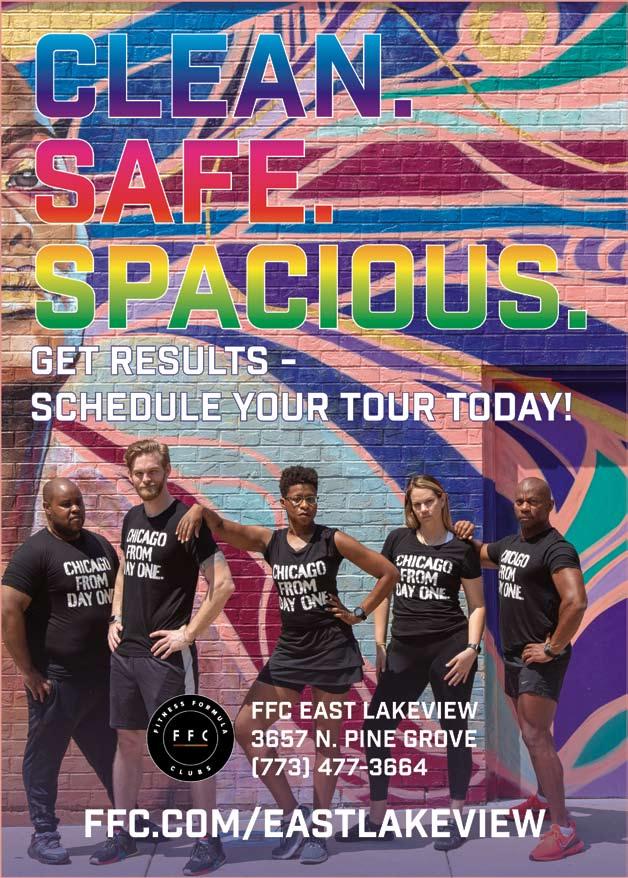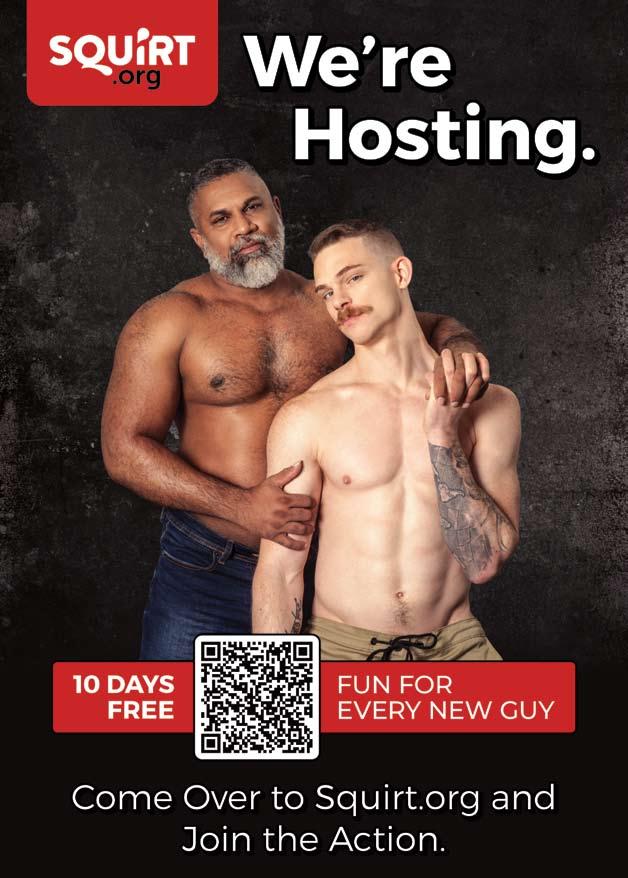


3024 N. Ashland #577063
Chicago, IL 60657
773.975.0264
Editorial: boieditorial@aol.com
Advertising: boiads@aol.com
EdiToriAL
Publisher: BOI Magazine, Inc.

Editor: Nate Daniels
Feature Editor: John Stephens
Media: Sylvia Stewart
Graphic design: Titanium Graphics
Layout specialist: Jerry Ellison
social Media: Mike@Night
National Media rep: Rivendell Media
disTriBUTioN: Chicago & suburbs: dsE (delivery service Enterprises)
World Wide distribution: AnyFlip Media Network
CovEr: Pridefest Chicago 2022 vi EW boiMAGazine o NL i NE at: www. boiMAG.com
Boi Magazine, inc. © 2000−2022. All rights reserved

To AdvErTisE: Call: 73.975.0264
or email: boiAds@aol.com
4 boiMAG.com

CHICAGO pr I de fest Information & Performance Schedule


The weekend before the 2022 Chicago Pride Parade (June 26), the Chicago pride fest returns for 2 days: June 18-19.
The festival features live music by headline artists and local favorites, 3 stages, food and drink, 150+ arts/crafts vendors, DJ’s and dancing, drag shows, pet parade, sponsored presence, games, giveaways and more.
The annual Chicago Pride Fest® is a legendary street festival, held the weekend before the Chicago Pride Parade (last Sunday in June). With upwards of 60,000 expected to attend, join us in celebrating LGBTQ+ life, culture and community.
A $15 suggested donation for entry helps pays performers and festival workers, and funds community programs. Generous public donations paid for the Chicago Pride Crosswalks; 14 rainbow paved intersections installed in 2019 that make up the longest installation of it’s kind in the world.
6 boiMAG.com


Stay In Shape, Get Fit and Stay Healthy
RunRepeat’s 2021 fitness trends report showed that 59.1% of active adults chose outdoor activities as their go-to way to stay fit. Whether it’s walking, hiking, mountain biking, or trail running, outdoor fitness will remain a popular fitness trend in 2022.
“Outdoor exercise, like biking and roller skating, are going to remain popular, E-bikes, in particular, are great for older adults because they allow them to go farther distances with less effort.”
Last summer, some fitness studios and gyms also hosted outdoor fitness classes, and these classes will continue during the warmer months.
The last few years has forced many to consider where and how they can work out outdoors. Whether you had to bundle up or stay cool, we got a bit more resilient when it came to being outside. Almost everyone can find a park, a boardwalk, or any available outdoor space to get it done.
For people with an anxiety disorder, exercise is often touted as a miracle cure for managing symptoms. And, in some ways, it is. There’s a growing body of research that suggests working up a sweat and moving your body can help you both cope with (and prevent) anxiety. It can be a powerful way to divert your focus from spiraling thoughts and even help regulate brain chemistry when you’re doing it on a consistent basis.


That said, “just work out” is a wildly oversimplified solution, and honestly, being told that feels trite when you’re living with the impacts of anxiety on the daily.
To understand how exercise can positively impact anxiety, it helps to have a sense of what’s actually happening in the brain and body when one is in the thick of it.
When you feel anxious, your body is alert, signaling your brain to prepare to fight or flight. What this means is that your brain floods your central nervous system with cortisol and adrenaline, which tell your body to prepare for danger. Whereas the sympathetic nervous system typically helps the brain and body calm down after sensing a threat, when you’re dealing with an anxious brain, reaching that level of calm may seem close to impossible.
The exercise-anxiety connection, enter, exercise. Hitting the gym releases mood-regulating neurotransmitters and chemicals including dopamine, serotonin, and endorphins, which can help chill out those feelings of anxiety and stress. It’s not more-ismore, though. Exercise has been shown to help “restore” balance in the brain in terms of neurotransmitters, rather than creating more. In anxious brains, neurotransmitters are not being transmitted from one cell to the next very efficiently, so it doesn’t get around the brain as effectively as it should. Exercise is one of the practices that can help regulate this.
f I t N ess
boiMAG.com 9



CULtUr AL CHANGes
2022 has been the year to hear about the great cultural change. 2021 led to many changes where companies began a process of great restructuring triggered by the pandemic. This created a lot of challenges for organizations, and primarily many of us hear a lot of the great resignation. However, there is a saying, “problems are opportunities for the one who takes right actions at the right time.” The problem is more profound when a trend sets on a global scale. Let’s for a minute focus on what is obvious.
O L d A ppA r At U s N eed CHANG e
We are following career architecture which is a decade old. It primarily focuses on skill-based segmentation and has become a tool to measure competence. It does not address people’s aspirations from all segments of the workforce. Old days a template was deciding the future of the masses. We cannot run career aspirations by a single template of offers and policies in today’s world.
New AG e te CHNOLOG y Pandemic could have been far more destructive if not for the 4G and technology provided and enabled by the tech industry. However, what we saw in the last two years has paved the future. New employee trends like a workcation, virtual offices, and virtual retail (meta) are the reality, which will further disrupt the workforce. An organization needs to address new HR policies and be agile to implement them. New-age companies are emerging and paving the way for massive transformation.
New p LAyers
Today’s consumer demands have been disrupted by technology, which startups are now disrupting. Mammoth organizations are adapting quickly and are seeding start-ups within their environments. Digital twins and more remote working will be the go-to solution of the future.
sOCIAL Be HAv IO r
It’s an area that is so crucial and driving so many trends and is amplified by the existing social medium. The current social world will transform into a new meta world where we will interact more digitally. Imagine yourself working in a virtual office with your view of your office is going to be where you can bring your pets or have your favorite food on your table without disturbing your colleague.
Privacy will be one of the most critical aspects employees will demand, with a constant need for policy transparency. We mostly have policies heavy on Intellectual property in today’s world, but there is no focus on individuals.
C HANGING wO rkf O r C e CO mp O s U re
In today’s work environment will have three segments:

A) A segment that has changed the world, they have lived through many iterations and changes. They have learned rules matter, and they feel patience and discipline drive success.
B) A segment which hungry and is brewing with confidence and is willing to bend the rules
C) A segment that is seen it all and is pretty much in the last phases of the work live. They are more focused on purpose and the outcome.
Today’s organizations will challenge amalgamate these three segments to drive their growth. The art of balancing their aspirations will be essential for success which needs to be ably supported by technology. So technology, while it disrupts the way we do things, should ideally play the balancer between these three segments.
So the first step will be to acknowledge that it’s time for a change, second be the change, third help others to sieve the change.
boiMAG.com 13
HOO k ING U p: meet t H e COLL e C t ION

At the Cleve Carney Museum of Art (CCMA)
“The College of DuPage has an amazing permanent collection featuring pieces by some of the most recognizable names from art history, and this exhibition highlights that,” says Cleve Carney Museum of Art Assistant Curator Julia walker. “It’s rare to find artists like Rembrandt and Warhol in a suburban museum, that’s why it was important for us to also bring in contemporary works that are capable of playing off these masters.”
The Cleve Carney museum of Art (CCMA) in Glen Ellyn, located at 425 Fawell Blvd. on the College of dupage campus, is presenting the “Hooking Up: meet the Collection,” on June 4 through August 7, 2022. This exhibition celebrates the recent conversion of the Cleve Carney Art Gallery to the Cleve Carney Museum of Art.

In this dynamic presentation, masters such as toulouse-Lautrec and rembrandt van rijn to 21st century artists maya Lin and kehinde wiley from the College of DuPage Permanent Art collection will be in conversation with works by notable contemporary Chicago artists including theaster Gates, sam Jaffe, Christopher James, troy Lehman, riva Lehrer, José Lerma, Britni mara, Audrey Niffenegger, Julia phillips, Jeffrey swider-peltz, taylor smith and Amanda williams.
For this exhibition, the museum’s gallery space will be transformed into a creative gathering space where visitors are encouraged to sketch, write and converse while taking inspiration from a wide range of artworks. Visitors are encouraged to participate by hanging their own work on a dedicated wall next to those of famous artists like Joan Miró, entering a piece of writing or visual art for publication in the Prairie Light Review and writing letters that will be delivered to artists featured in the exhibition.
“Museums should be lively, welcoming and enriching spaces where the community can come together,” says Julia Walker, who hopes visitors to the CCMA this summer will make themselves at home in the museum.
The works of these artists and others from both the College of DuPage Permanent Art collection and beyond will spark a dialogue between historical precedents and issues contemporary artists address today, while bringing members of the community together to engage in thoughtful discussion about works on display.
14 boiMAG.com


What's Art Got To Do With It?
by: Dr. Charla Waxman BS, MBA, EdD
It is said that what is created under the auspices of art cannot fail and cannot lie. This is just one reason among many that art for healing and recovery is so valuable.
Art is many things. Art is dance and movement, art is music, journaling and poetry and art is mediums of drawing, painting and sculpting. Art is the essence of creativity.
Combine creation and healing and a “newness” happens naturally. A new way of seeing things, a new reason for doing things, and a newly developed sense of self can spur emotions, dialogue, and hope for a future welllived.

Have you taken the time to use your idea of self and of art to energize you? Have you ever found that a blue mood was made better by writing or drawing? Are there certain songs that take you back to another time or place? If so, you have utilized the arts for the purposes of mental health.
Think about what inspires you and what you would enjoy doing: paint, dance, collage, or sculpt? Whatever it is, try it! Art can help you reduce stress and anxiety, manage behaviors or help you process feelings and past life events.
You say you have no artistic talent? It just doesn’t matter! Art is about
searching, it’s not about perfection. Art is more about the process than the product. Art is all about you. It boosts self-esteem, fights stress and anxiety, provides emotional release, and promotes self-discovery (rtor.org).
If art therapy is something that peaks your interest, start with the best. Find a qualified art therapist. A good place to try is the Art Therapy Credentials Board website. You may even be able to use your health insurance to help cover costs. Find a psychologist or master’s degreed therapist who has art therapy credentials; this may insure that your health insurance will approve your sessions.
Finally, make sure their art specialties match your areas of interest and that the therapist feels your mental health concern can improve with the use of art therapy. Be ready to talk through issues that bring you to seek support and what your personal goals are in working on healing through art.

The healing benefits of art are proven. If you would like a new perspective and maybe a new way of finding yourself; so why not try it?

H e ALt
H & we LL N ess
boiMAG.com 17
by: Dr. Charla Waxman BS, MBA, EdD,
Eating Disorders: Widespread and Dangerous

Eating disorders has been addressed in BOI magazine before. This time we’ll take a look at how it specifically affects gay and bisexual men.
No matter the population, eating disorders has the highest mortality rate of any mental illness (National Eating Disorder Association). As an example, from NEDA, we learn that 20% of those with an rexia nervosa (the state of eating disorders that features an obsession with weight loss or control through minimal food intake) die from complications of the disorder; ie, heart attack or suicide.
Although eating disorders are often associated with women, gay and bisexual men may even be at higher risk. A Columbia University study, from the Mailman School of Public Health (2007), completed a first-of-itskind review of eating disorders that definitively identified gay and bisexual
men as “at-risr for eating disorders. In this study, surveying 516 New York City residents (126 straight men, the rest were gay and bisexual men and women), 15% of the gay and bisexual men struggled with some form of eating disorders. In a discussion of potential causes, it was indicated that this may be related to bodycentric focus and high expectations of physical appearance in the gay community. Other related causes included stress and prejudice-related interactions with community members and the work place.
According NEDA (unrelated to the study), gay and bisexual men report fasting, vomiting, use of laxatives and diet supplements to control weight. Although gay men represent only 5% of the total male population, 42% of men who identify as having an eating disorder are gay or bisexual. Of all of the “States” of eating disorders, NEDA indicates that bulimia (characterized by binging on large amounts of food, often in a short time period, then purging to rid oneself of the calories) affects gay men more than others forms of eating disorders.
Continued >> 18 boiMAG.com



E ATING D ISORDERS
Widespread and Dangerous
Part of the reason that so many in the gay community suffer, and sometimes die from eating disorders is that there is always stigma related to mental health. For all populations and all cultures, the National Alliance on Mental Illness, indicates that about 40% of those needing mental health services do not seek or receive treatment. In the gay community a barrier to treatment may include fewer gay-friendly or gayunique therapy services. In addition, there may be reduced friend or family support. Education, of course, Is always a factor and information about men who have eating disorders and how to effectively treat them may be unavailable.
If you love someone who has an eating disorder, consider these ways to provide Support and offer them a chance for recovery.
1.Take all threats of suicide seriously and seek immediate help.
2. Tell them what you observe and that help is available. Even if the observation is not well received, maybe you have sparked interest in what kind of help is out there and you will have certainly let them know you are paying attention and that you care. You don’t have to be a nag, but keep them on your radar. When the time feels right, try again.
3. Stay away from the “just eat a sandwich” or “I’ll show you how to eat healthy” solutions. Remember, what looks like a decision may really be an obsession. Mental illness can’t just be “willed” away. Don’t withdraw support if the eating disordered behavior continues.
4. Reduce stigma by sharing facts from places like NEDA and NAMI. It may help your loved one understand that they are truly not alone. Read all you can, get yourself knowledgeable, so the facts you share are real.
5. Never promise not to tell. You may need to make calls to get them support or notify a friend who can help you be a helper.
6. Set a time and place to talk. This may take a while. It will be emotion charged and those kind of discussions take time.
7. When you do meet up, have an idea of what you want to convey. Practicing or even writing down what you want to say may make it easier on you.
8. Remember when you learned about “I” statements in grade school? Well that applies here. Starting a sentence with “You” can mean a defensive answer will follow. Open with: “I noticed that , I am worried because, or I am concerned about you...”.
Use these eating disorder hotlines to help you help others:
NEDA: 1 800 931 2237 (a help line, but not 24 hours)
Hopeline Network: 1 800 442 4673 they may answer with “suicide hotline”, but they serve all emotional disorders, 24/7)

Overeaters Anonymous: 1 505 891 2664
TalkLine: 1 800 273 8255 ( they also deal with all mental health struggles and will route you to the best place to help you)
22 boiMAG.com



boiMAG.com 25
ALAsk A tHUNderf*Ck

One of the Many Performers at Chicago Pride Fest
A bizarre cosmic collision propelled Alaska to Earth…and onto the fifth season of “rupaul’s drag race,” where she finished in the final 3 before returning and taking the crown as winner of season two of “RuPaul’s Drag Race All Stars.”
She has released three charttopping studio albums, “Anus,” “Poundcake” and “Vagina” (available on iTunes), been a cast member of VH1’s hit reality series “Scared Famous,”released a young adult novel titled “Alaska Thunderfun and the Inner Space Odyssey” (part of the “Sickening Adventures” fiction series, available everywhere books are sold online), stars as Hattie in the short horror film “The Quiet Room” directed by Sam Wineman and toured the globe spreading her otherworldly message of love, kindness and gender nonconformity.
Alaska also co-hosts the wildly popular Race Chaser podcast with Willam and her Youtube videos boast over 60 million views with 15 million views alone (and counting) for 2017’s “The T.” She has over 1.7 million insta followers and over 1.1 million twitter & FB followers. Her message to humankind? “If you’re not wearing nails, you are not doing drag.”

26 boiMAG.com

 by Jack Santo
by Jack Santo
AI is the “brains” that will guide the autonomous cars, boats, and aircraft that are set to revolutionize travel and society over the coming decade. 2022 should be a year to remember when we look back in the future and contemplate with horror the fact that we thought it was normal that 1.3 million people died of traffic accidents every year, 90% of which were caused by human error!
As well as increasingly effective autonomous cars, Tesla says its cars will demonstrate full self-driving capability by 2022, although it’s unlikely they will be ready for general use. Its competitors include Waymo (created by Google), Apple, GM, and Ford, and any of them can be expected to announce major leaps forward in the next year. The year will hopefully also see the first autonomous ship crossing the Atlantic, as the Mayflower Autonomous Ship (MAS), powered by IBM and designed in partnership with non-profit ProMare, will once again attempt the journey (having been forced to turn back during its initial attempt this year).


We know now that AI can be used to create art, music, poetry, plays, and even video games. In 2022, as new models such as GPT-4 and Google’s Brain redefine the boundaries of what’s possible, we can expect more elaborate and seemingly “natural” creative output from our increasingly imaginative and capable electronic friends. Rather than these creations generally being demonstrations or experiments to show
off the potential of AI, as is the case now, in 2022, we will increasingly see them applied to routine creative tasks, such as writing headlines for articles and newsletters, designing logos and infographics. Creativity is often seen as a very human skill, and the fact we are now seeing these capabilities emerging in machines means “artificial” intelligence is undeniably coming closer in terms of scope and function to the somewhat nebulous concept we have of what constitutes “real” intelligence.
The topic of Robotics is not new and has been steadily growing in the manufacturing and healthcare industry ever since more intelligent automation took off many decades ago. A lot of the robotics systems seen today are mainly hard-to-program stationary robots like robotic arms for welding, etc. The trend now goes into making these easier to program with machine teaching and getting these stationary robots on the move, which we see more and more with autonomous mobile robots (AMR). Predictions say that by 2030, 75% of the robots shipped worldwide will be mobile (6 out of 8 million). The Reply Network is at the forefront of this trend, being part of a few selected companies in the Boston Dynamics Early Adopter Program for the SPOT robot dog, which has been applied to interesting challenges with our clients. We also announced our deeper partnership with Microsoft and the reference architecture for autonomous mobile robots.
Continued >>
boiMAG.com 29
TECH TRENDS CONTINUED
IoT and Digital Twins have been an ongoing topic for the manufacturing sector but now they are also entering retail, utilities sector, automotive and many other industries and their consumers. The topic becomes even more interesting with the bigger picture of Smart Spaces which market research companies also feature for their trends to watch closely. Smart Spaces are physical or digital places and locations with interconnected sensors to give owners, occupants and managers better information and how the system is leveraged. Smart Cities is a flavor that is often discussed where whole cities become smarter and allow for more resource sensitive usage. Smart spaces offer a great way across industries whenever traffic, people, robots and other machines require analytics and efficient management. Smart Spaces also tie into the Real-World Metaverse technology allowing to add a smart, digital layer on top of the world.
Devices can sense the physical world and provide more precise context for Augmented, Virtual and Mixed Reality (AR/VR/MR) scenarios. Valorem Reply is a long time Microsoft Mixed Reality partner, and our experienced team developed many innovative solutions gaining ROI for our clients.

In 2021 a 30-year-old terminology gained new traction and became top of mind for many business leaders: The Metaverse. We also looked at the whole topic from a 10000-foot view in our November 2021 article and also mentioned the potential benefits for professional users with the Enterprise Metaverse. There’s currently a lot of hype and potentially a bit too much hype in particular on the decentralization web3 aspect of the Metaverse with NFTs. Aside from this overhype, we believe there’s real potential in web3 and the Metaverse, that will enable new beneficial experiences not just for consumers but also for corporations with their own branded Corporate Metaverse spaces. Another interesting flavor is the Real-World Metaverse, the AR Cloud, essentially a Digital Twin of our world, a digital content layer that is persisted and mapped to real objects and locations in the physical world. Virtual content can be anchored in the realworld, shared cross-platform, between platforms and over time.
Spatial Computing is a favorite topic of our R&I team and we have been creating content around it for quite some time and will continue the journey, as it is still very much an emerging technology that will change how we interact with computers and the world. Mainly driven by AI computer vision and advanced sensors.
It’s just the beginning of the Metaverse with the puzzle pieces of AI, Spatial Computing and decentralized protocols like blockchain becoming mature enough. We are deeply committed to this and recently launched a Metaverse landing page as we expect to see more gain this year, just like Forrester and the rest of the world are expecting huge growth opportunities here.
30 boiMAG.com



































 by Jack Santo
by Jack Santo









